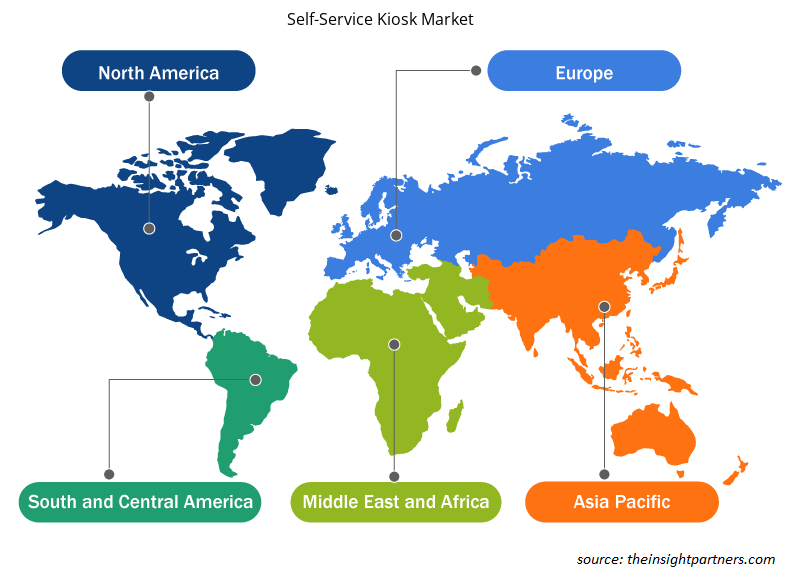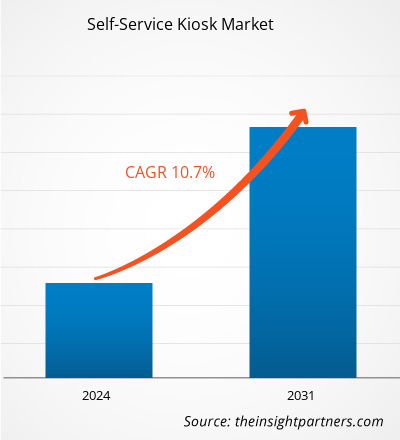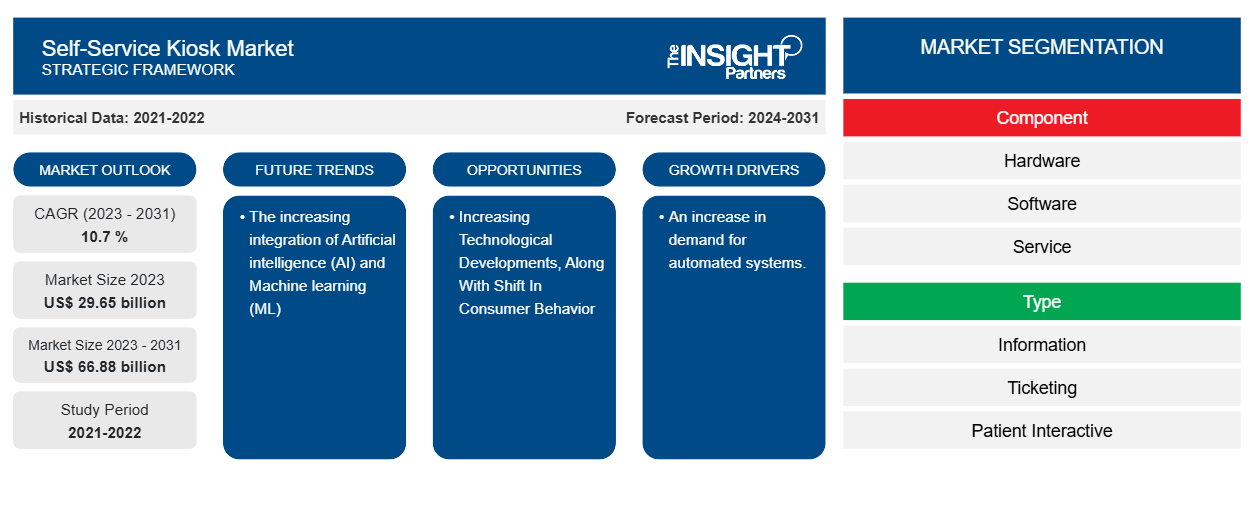셀프서비스 키오스크 시장 규모는 2023년 296억 5천만 달러에서 2031년 668억 8천만 달러로 성장할 것으로 예상됩니다. 이 시장은 2023~2031년 동안 10.7%의 CAGR을 기록할 것으로 예상됩니다.CAGR of 10.7 % in 2023–2031. 인공지능(AI)과 머신러닝(ML)의 점차 더 큰 통합은 앞으로도 셀프서비스 키오스크 시장의 주요 추세가 될 가능성이 높습니다.
셀프 서비스 키오스크 시장 분석
현금 자동 입출금기, 티켓 발매기 , 모바일 스캐너는 기술적 혁신과 발명으로 가능해진 셀프 서비스 기술 및 서비스의 예입니다. 셀프 서비스 키오스크는 은행, 공항, 리테일 센터, 병원, 테마파크에서 점점 더 흔해지고 있습니다. 고객 편의성을 개선하는 것은 혁신과 기술이 꾸준히 개발된 셀프 서비스 키오스크 산업의 초점으로 남아 있습니다. 이러한 추세는 앞으로도 계속될 것으로 예상됩니다. 진보된 가전제품으로 부자가 된 소비자의 수가 증가함에 따라 셀프 서비스 키오스크에 대한 수요가 증가하고 있습니다. 서비스 제공업체는 수년 동안 다양한 셀프 서비스 제공 메커니즘을 제공해 왔습니다. 여기에는 대화형 음성 응답 시스템, 셀프 서비스 키오스크, 모바일 셀프 서비스, 인터넷 기반 서비스 등이 포함됩니다.
셀프 서비스 키오스크 시장 개요
공공 부문에서 셀프 서비스 키오스크는 때때로 컴퓨터 단말기라고도 하며, 사용자가 사용하기 쉬운 인터페이스를 통해 디지털 콘텐츠 및 정보와 상호 작용할 수 있는 셀프 서비스 장치 또는 가젯입니다. 대화형 키오스크는 소매 판매, 청구서 지불, 길찾기, 정보 교환 및 관광에 사용됩니다. 이러한 키오스크는 여행 및 의료 분야와 같이 다양한 맥락에서 사용되는데, 이는 고객으로부터 개인 데이터를 수집하는 과정을 단순화하기 때문입니다.
귀하의 요구 사항에 맞게 이 보고서를 사용자 정의하세요
이 보고서의 일부 또는 국가 수준 분석, Excel 데이터 팩을 포함하여 모든 보고서에 대한 사용자 정의를 무료로 받을 수 있으며 신생 기업 및 대학을 위한 훌륭한 혜택과 할인 혜택을 이용할 수 있습니다.
- 이 보고서의 주요 시장 동향을 알아보세요.이 무료 샘플에는 시장 동향부터 추정 및 예측까지 다양한 데이터 분석이 포함됩니다.
셀프 서비스 키오스크 시장 동인 및 기회
자동화 시스템에 대한 수요 증가.
자동화 시스템에 대한 필요성이 커지면서 셀프 서비스 키오스크 시장이 급증했습니다. 이러한 장치는 수동 서비스에 비해 작동 시간을 줄이고 일반적으로 고객 만족도를 높이기 때문입니다. 셀프 서비스 키오스크 기술은 또한 소매 산업에서 더 자주 사용되고 있습니다. 이러한 혁신은 실제 시설 내부와 외부에서 역동적인 브랜드 경험을 제공합니다. 결과적으로 대화형 기술이 소매 애플리케이션에 통합됨에 따라 셀프 서비스 키오스크에 대한 수요가 증가할 것이라는 것은 당연한 일입니다.
소비자 행동의 변화와 함께 증가하는 기술 개발
비즈니스, 교육, 소매, 스포츠 및 엔터테인먼트, 운송을 포함한 여러 산업 분야에서 새로운 기술이 향상된 시각화를 제공합니다. 대화형 키오스크는 구매 결정에 대한 통제권을 고객에게 부여하여 많은 고객을 유치할 수 있는 잠재력이 있으며, 이는 고객 만족도를 높일 것입니다. 셀프 서비스 도구로 알려진 기술 인터페이스를 통해 고객은 서비스 제공자와 별도로 서비스를 사용할 수 있습니다. 자동화 장비 및 셀프 서비스 키오스크에 대한 수요 증가, 무선 연결, 기술 발전, 원격 관리와 같은 수많은 요소가 셀프 서비스 키오스크 산업에 상당한 영향을 미치고 있습니다. 이러한 요소가 시장에 새로운 기회를 제공할 것으로 예상됩니다. 따라서 소비자 행동의 변화와 함께 증가하는 기술 개발은 예측 기간 동안 셀프 서비스 키오스크 시장 참여자에게 새로운 기회를 제공할 것으로 예상됩니다.
셀프 서비스 키오스크 시장 보고서 세분화 분석
셀프서비스 키오스크 시장 분석에 기여한 주요 세그먼트는 구성 요소, 유형 및 최종 사용자입니다.
- 구성 요소에 따라 셀프 서비스 키오스크 시장은 하드웨어, 소프트웨어 및 서비스로 세분화됩니다. 하드웨어 세그먼트는 2023년에 더 큰 시장 점유율을 차지했습니다.
- 유형별로 시장은 정보, 티켓팅, 환자 상호작용, 체크인, 고용 및 기타로 세분화됩니다. 체크인 세그먼트는 2023년에 시장에서 가장 큰 점유율을 차지했습니다.
- 최종 사용자별로 시장은 소매, 호텔, 의료, 금융 서비스 등으로 세분화됩니다.
지역별 셀프 서비스 키오스크 시장 점유율 분석
셀프 서비스 키오스크 시장 보고서의 지리적 범위는 주로 북미, 아시아 태평양, 유럽, 중동 및 아프리카, 남미/남중부 아메리카의 5개 지역으로 나뉩니다. 수익 측면에서 북미는 가장 큰 셀프 서비스 키오스크 시장 점유율을 차지했습니다. 미국과 캐나다에서는 소비자가 키오스크에서 물건을 살 가능성이 더 높습니다. 이 시장은 높은 재량 소득과 줄을 서서 기다리는 시간이 짧은 빠른 쇼핑 경험에 대한 필요성이 결합되어 확장되고 있습니다.
셀프 서비스 키오스크 시장 지역 통찰력
Insight Partners의 분석가들은 예측 기간 동안 셀프 서비스 키오스크 시장에 영향을 미치는 지역적 추세와 요인을 철저히 설명했습니다. 이 섹션에서는 북미, 유럽, 아시아 태평양, 중동 및 아프리카, 남미 및 중미의 셀프 서비스 키오스크 시장 세그먼트와 지리에 대해서도 설명합니다.

- 셀프 서비스 키오스크 시장에 대한 지역별 데이터 얻기
셀프 서비스 키오스크 시장 보고서 범위
| 보고서 속성 | 세부 |
|---|---|
| 2023년 시장 규모 | 296억 5천만 달러 |
| 2031년까지 시장 규모 | 668억 8천만 달러 |
| 글로벌 CAGR (2023-2031) | 10.7% |
| 역사적 데이터 | 2021-2022 |
| 예측 기간 | 2024-2031 |
| 다루는 세그먼트 | 구성 요소별로
|
| 포함된 지역 및 국가 | 북아메리카
|
| 시장 선도 기업 및 주요 회사 프로필 |
|
시장 참여자 밀도: 비즈니스 역학에 미치는 영향 이해
셀프 서비스 키오스크 시장은 소비자 선호도의 변화, 기술 발전, 제품의 이점에 대한 인식 증가와 같은 요인으로 인해 최종 사용자 수요가 증가함에 따라 빠르게 성장하고 있습니다. 수요가 증가함에 따라 기업은 제품을 확장하고, 소비자의 요구를 충족하기 위해 혁신하고, 새로운 트렌드를 활용하여 시장 성장을 더욱 촉진하고 있습니다.
시장 참여자 밀도는 특정 시장이나 산업 내에서 운영되는 회사나 기업의 분포를 말합니다. 주어진 시장 공간에 얼마나 많은 경쟁자(시장 참여자)가 존재하는지 그 규모나 총 시장 가치에 비해 나타냅니다.
셀프서비스 키오스크 시장에서 운영되는 주요 회사는 다음과 같습니다.
- 아크렐렉 그룹
- 엠브로스
- 제말토
- 키오스크 정보 시스템
- 메리디안 키오스크
- NCR 주식회사
면책 조항 : 위에 나열된 회사는 어떤 특별한 순서에 따라 순위가 매겨지지 않았습니다.

- 셀프 서비스 키오스크 시장 주요 업체 개요 알아보기
셀프 서비스 키오스크 시장 뉴스 및 최근 개발
셀프 서비스 키오스크 시장은 1차 및 2차 조사 후 질적, 양적 데이터를 수집하여 평가합니다. 여기에는 중요한 기업 간행물, 협회 데이터 및 데이터베이스가 포함됩니다. 다음은 언어 장애 및 전략 시장에서의 개발 목록입니다.
- 2021년 8월, 자산이 27억 달러인 TruMark Financial Credit Union은 소매 및 비즈니스 회원에게 보다 매끄럽고 균일한 디지털 뱅킹 경험을 제공하기 위해 NCR을 선택했습니다. TruMark Financial은 NCR Digital Banking을 통해 소비자와 회사 모두에게 간단한 경험을 제공할 수 있습니다. (출처: NCR Digital Banking, 보도자료)
- 2021년 10월, Zebra Technologies Corporation은 소매 및 CPG 부문의 예측 및 상품화를 위한 SaaS(Software-as-a-Service) 솔루션 공급업체인 antuit.ai를 인수했다고 발표했습니다. (출처: Zebra Technologies Corporation, 보도자료)
셀프 서비스 키오스크 시장 보고서 범위 및 제공물
"셀프 서비스 키오스크 시장 규모 및 예측(2021-2031)" 보고서는 아래 영역을 포괄하는 시장에 대한 자세한 분석을 제공합니다.
- 범위에 포함된 모든 주요 시장 세그먼트에 대한 글로벌, 지역 및 국가 수준의 시장 규모 및 예측
- 동인, 제약 및 주요 기회와 같은 시장 역학
- 주요 미래 트렌드
- 자세한 PEST/포터의 5가지 힘 및 SWOT 분석
- 주요 시장 동향, 주요 업체, 규정 및 최근 시장 동향을 포괄하는 글로벌 및 지역 시장 분석
- 시장 집중도, 히트맵 분석, 유명 기업 및 최근 개발 사항을 포함하는 산업 환경 및 경쟁 분석
- 자세한 회사 프로필
- 과거 분석(2년), 기준 연도, CAGR을 포함한 예측(7년)
- PEST 및 SWOT 분석
- 시장 규모 가치/거래량 - 글로벌, 지역, 국가
- 산업 및 경쟁 환경
- Excel 데이터세트
최근 보고서
사용 후기
구매 이유
- 정보에 기반한 의사 결정
- 시장 역학 이해
- 경쟁 분석
- 고객 인사이트
- 시장 예측
- 위험 완화
- 전략 기획
- 투자 타당성 분석
- 신흥 시장 파악
- 마케팅 전략 강화
- 운영 효율성 향상
- 규제 동향에 발맞춰 대응





















 무료 샘플 받기 - 셀프서비스 키오스크 시장
무료 샘플 받기 - 셀프서비스 키오스크 시장